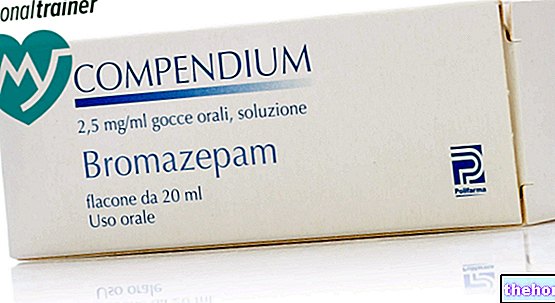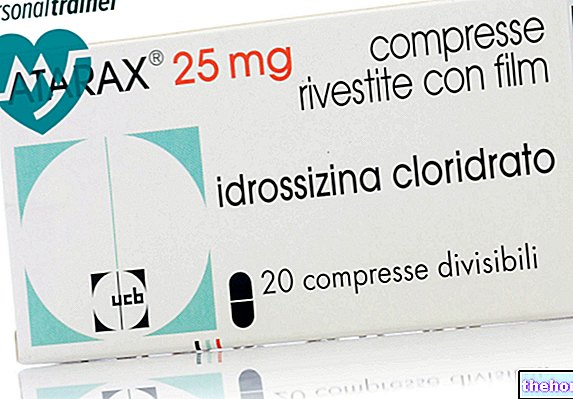Active ingredients: Clonidine
CATAPRESAN 150 micrograms tablets
CATAPRESAN 300 micrograms tablets
CATAPRESAN 150 micrograms / ml solution for injection
Why is Catapresan used? What is it for?
PHARMACOTHERAPEUTIC CATEGORY
Antihypertensive - Imidazoline receptor agonist
THERAPEUTIC INDICATIONS
Oral way
All forms of arterial hypertension
Injecting
Hypertensive crises and cases of hypertension in which there is a temporary "impossibility of oral administration or this does not prove effective enough. The parenteral route is reserved for hospitalized cases."
Contraindications When Catapresan should not be used
Catapresan must not be administered to patients with known hypersensitivity to the active substance or to any of the excipients and to patients with severe bradyarrhythmia caused by either sick sinus disease or 2nd or 3rd degree atrioventricular block.
The use of the medicinal product is contraindicated in case of rare hereditary conditions which may be incompatible with one of the excipients of the product (see: "Special warnings").
Precautions for use What you need to know before taking Catapresan
Catapresan should be administered with caution in patients with severe coronary insufficiency, chronic renal insufficiency, cerebrovascular disease, recent myocardial infarction and mild or moderate bradyarrhythmia, constipation. Administration in patients suffering from polyneuropathy, Raynaud's disease and other obstructive affections of the peripheral circulation should be carried out with extreme caution; similar precautions should be observed in depressed patients or those who have suffered from depressive disorders, as cases of onset or accentuation of such disorders have been reported during treatment with clonidine.
Catapresan is not effective in pheochromocytoma hypertension.
Clonidine, the active substance of Catapresan and its metabolites are extensively excreted via the kidneys. In case of renal insufficiency, a particularly careful dosage adjustment is necessary (see: "Dose, method and time of administration"). Treatment with Catapresan, as with other antihypertensive drugs, should be monitored with particular care in patients with heart failure or severe coronary artery disease.
During the first week of treatment, the hypotensive action of Catapresan may be accompanied by a sedative effect. Sedation usually subsides during the continuation of therapy. If necessary, a reduction in the dosage should be carried out under medical supervision.
Clonidine may potentiate the action of other CNS depressants, such as opioid agonists, analgesics, barbiturates, sedatives, anesthetics or alcohol.
Any suspension of treatment must take place exclusively under medical supervision and gradually with graduated doses, over a few days, in order to avoid a consequent sharp increase in blood pressure with the classic symptoms (agitation, palpitations, nervousness, tremor, headache, nausea etc.). Patients should therefore be advised not to discontinue therapy without first consulting the treating physician.
If therapy is to be discontinued, the physician should gradually reduce the dose over 2-4 days. An excessive increase in blood pressure following discontinuation of Catapresan can be reversed by intravenous administration of phentolamine or tolazoline (see : "Interactions"). If it is necessary to discontinue concomitant long-term ß-blocker treatment, the ß-blocker should be discontinued several days before the gradual withdrawal of clonidine.In patients who have experienced local skin reactions to the Catapresan transdermal patch, switching to oral therapy with clonidine may result in a widespread rash.
Patients using contact lenses should be advised that treatment with Catapresan may reduce tearing of the eyes.
The use and safety of use of clonidine in children and adolescents has found little evidence in controlled, randomized studies; therefore use in this patient population cannot be recommended
In particular, serious adverse reactions, including death, were observed when clonidine was used "off-label" in combination with methylphenidate in children with ADHD (attention deficit hyperactivity syndrome). Therefore, the use of clonidine in this combination is not recommended.
Interactions Which drugs or foods can modify the effect of Catapresan
"Please inform your doctor or pharmacist if you have recently taken any other medicines, even those without a prescription"
The reduction in blood pressure induced by clonidine may be enhanced by concomitant administration of other hypotensive drugs. This can be exploited therapeutically by administering other types of antihypertensives such as diuretics, vasodilators, ß-blockers, calcium channel blockers and ACE inhibitors, but not α1-blockers.
Drugs that induce increased blood pressure or water and sodium ion retention, such as non-steroidal anti-inflammatory drugs, may reduce the effectiveness of clonidine.
Substances with α2-blocking activity, such as phentolamine or tolazoline, may inhibit the α2-mediated effects of clonidine in a dose-proportional manner.
Concomitant administration of substances with negative chronotropic or dromotropic activity such as ß-blockers or digitalis glycosides may cause or potentiate rhythm disturbances in bradycardias. It cannot be excluded that concomitant administration of a ß-blocker may cause or potentiate peripheral vascular dysfunction.
The concomitant administration of tricyclic or neuroleptic antidepressants with α-blocking activity can reduce or cancel the antihypertensive effect of clonidine and cause or aggravate the phenomena of alteration of orthostatic regulation.
Observation of patients in alcohol-induced delirium shows that intravenous administration of high doses of clonidine may increase the arrhythmogenic potential (prolongation of the QT segment of the ECG and ventricular fibrillation) of high doses of intravenous haloperidol.
Causal relationship and relevance of antihypertensive treatment have not been established.
The CNS depressant effects of drugs, as well as alcohol, may be enhanced by the concomitant administration of clonidine.
Warnings It is important to know that:
Catapresan tablets contain lactose; if you have been told by your doctor that you have an intolerance to some sugars, contact your doctor before taking this medicinal product.
Catapresan solution for injection contains less than 1 mmol sodium (23 mg) per vial, ie it is essentially "sodium free".
Fertility, pregnancy and breastfeeding
Ask your doctor or pharmacist for advice before taking any medicine.
Pregnancy
There are limited data on the use of clonidine in pregnant women.
During pregnancy, Catapresan, like any drug, should be administered only in cases of real need and under the direct supervision of the doctor. Close monitoring of the mother and baby is recommended. Clonidine crosses the placental barrier and can reduce the heart rate of the fetus. There are insufficient data regarding the long-term effect of prenatal drug exposure.
Oral forms of clonidine are preferred during pregnancy.
Intravenous administration of clonidine should be avoided.
Animal studies do not indicate direct or indirect harmful effects with respect to reproductive toxicity. A transient increase in the blood pressure of the newborn may occur after delivery.
Feeding time
Clonidine is excreted in breast milk. However, there is insufficient information regarding the effects of clonidine on neonates. The use of Catapresan is therefore not recommended during breastfeeding.
Fertility
No clinical studies on the effect of clonidine on human fertility have been conducted. Studies with clonidine in animals do not indicate direct or indirect harmful effects on fertility index.
Effects on ability to drive and use machines
No studies on the ability to drive and use machines have been performed.
However, patients should be warned of the possible onset of undesirable effects such as dizziness, sedation and disturbances of accommodation during treatment with Catapresan. Therefore, caution should be advised when driving or operating machinery. If patients experience the side effects mentioned above they should avoid potentially hazardous activities such as driving or operating machinery.
Dosage and method of use How to use Catapresan: Dosage
Treatment of hypertension requires constant medical supervision.
The dose of Catapresan should be determined according to the blood pressure response of the individual patient.
CATAPRESAN 150 micrograms tablets
Indicated in mild and moderate arterial hypertension and, in particular, in the treatment of elderly patients, who are more sensitive to the action of the drug. It is recommended to start treatment with ½-1 tablet per day, preferably in the evening; this posology has been shown to be effective in most of the patients treated. In case of insufficient response, gradually increase the dosage up to 3 tablets per day.
CATAPRESAN 300 micrograms tablets
In the forms of severe arterial hypertension, as attack therapy, Catapresan 300 micrograms tablets will be used, administering an average of 1 tablet 2-3 times a day. In extremely resistant cases, higher doses can be used, to be administered under medical supervision and in the context of a hospital ward.
CATAPRESAN 150 micrograms / ml solution for injection
In hypertensive crises and in hospitalized patients, Catapresan 150 micrograms / ml solution for injection can be used.
Administration by subcutaneous or i.m. of Catapresan 150 micrograms / ml solution for injection must be carried out with the patient in a supine position to avoid occasional orthostatic phenomena.
The injection can be made subcutaneously, intramuscularly or slowly intravenously (1 ampoule diluted in at least 10 ml of physiological saline solution, duration of injection 10 minutes). For IV infusion, a dose of 0.2 micrograms / kg / min is recommended. The rate of infusion should not exceed 0.5 micrograms / kg / min to avoid transient increases in blood pressure. 150 micrograms.
If necessary, the ampoules can be administered parenterally 4 times a day.
This medicinal product must not be mixed with other products except physiological saline.
Kidney failure
The dose needs to be corrected:
- as a function of the individual response to the antihypertensive, which can be highly variable in patients with renal insufficiency;
- as a function of the degree of renal impairment.
Close monitoring is required. Since only a very small fraction of clonidine is eliminated by routine hemodialysis, there is no need to further administer the drug after dialysis.
Pediatric population
There is insufficient evidence to support the use of clonidine in children and adolescents under the age of 18 years.
The use of clonidine is therefore not recommended in pediatric subjects below 18 years of age.
Instructions for use and handling:
Pre-cut vials. You don't need a lime.
Overdose What to do if you have taken too much Catapresan
Symptoms:
Clonidine is characterized by a broad therapeutic spectrum. Clonidine intoxication is manifested by a general depression of the sympathetic, which includes constriction of the pupil, lethargy, bradycardia, hypotension, hypothermia, somnolence up to coma, respiratory depression tending to apnea. Paradoxical hypertension may also occur following stimulation of peripheral α1 receptors.
Treatment:
Emergency treatment consists of gastric lavage and the administration of analeptic and / or vasopressor drugs.
In case of accidental ingestion / intake of an overdose of Catapresan, notify your doctor immediately or go to the nearest hospital.
If you have any further questions on the use of Catapresan, ask your doctor or pharmacist.
Side Effects What are the side effects of Catapresan
Like all medicines, Catapresan can cause side effects, although not everybody gets them.
Most of the side effects are mild and tend to diminish over the course of therapy.
Adverse reactions are listed below by system organ class and frequency, according to the following categories:
Very common ≥ 1/10
Common ≥ 1/100 <1/10
Uncommon ≥ 1 / 1,000 <1/100
Rare ≥ 1 / 10,000 <1 / 1,000
Very rare <1 / 10,000
Not known frequency cannot be estimated from the available data.
Endocrine disorders:
Rare: Gynecomastia
Psychiatric disorders:
Common: Depression, sleep disturbances
Uncommon: Delusional perception, hallucinations, nightmares
Not known: Confusional state, decreased libido
Nervous system disorders:
Very common: Vertigo, sedation
Common: Headache
Uncommon: Paresthesia
Eye disorders:
Rare: Reduced tear flow
Not known: Disorders of accommodation
Cardiac disorders:
Uncommon: Sinus bradycardia
Rare: Atrioventricular block
Not known: Bradyarrhythmias
Vascular disorders:
Very common: Orthostatic hypotension
Uncommon: Raynaud's syndrome
Respiratory, thoracic and mediastinal disorders:
Rare: Dryness of the nasal mucosa
Gastrointestinal disorders:
Very common: Dry mouth
Common: Constipation, nausea, salivary gland pain, vomiting
Rare: Pseudo-obstruction of the large intestine
Skin and subcutaneous tissue disorders:
Uncommon: Pruritus, rash, urticaria
Rare: Alopecia
Reproductive system and breast disorders:
Common: Erectile dysfunction
General disorders and administration site conditions:
Common: Fatigue
Uncommon: Malaise
Diagnostic tests:
Rare: Increased blood sugar
Compliance with the instructions contained in the package leaflet reduces the risk of undesirable effects.
If any of the side effects gets serious, or if you notice any side effects not listed in this leaflet, please tell your doctor or pharmacist.
Expiry and Retention
Expiry: see the expiry date printed on the package.
The expiry date indicated refers to the product in intact packaging, correctly stored.
Warning: do not use the medicine after the expiry date shown on the package.
Keep this medicine out of the sight and reach of children.
Medicines should not be disposed of via wastewater or household waste. Ask your pharmacist how to throw away medicines you no longer use. This will help protect the environment.
COMPOSITION
CATAPRESAN 150 micrograms tablets
One tablet contains:
Active ingredient: clonidine hydrochloride 150 micrograms
Excipients: corn starch, dibasic calcium phosphate, lactose monohydrate, anhydrous colloidal silica, soluble starch, povidone, stearic acid
CATAPRESAN 300 micrograms tablets
One tablet contains:
Active ingredient: clonidine hydrochloride 300 micrograms
Excipients: corn starch, dibasic calcium phosphate, lactose monohydrate, anhydrous colloidal silica, soluble starch, povidone, stearic acid
CATAPRESAN 150 micrograms / ml solution for injection
One vial contains:
Active ingredient: clonidine hydrochloride 150 micrograms
Excipients: sodium chloride, hydrochloric acid 1 N c.a., water for injections
PHARMACEUTICAL FORM
Tablets:
150 micrograms - 30 tablets
300 micrograms - 30 tablets
Solution for injection for subcutaneous, intramuscular and slow intravenous use:
150 micrograms / ml - 5 ampoules of 1 ml
Source Package Leaflet: AIFA (Italian Medicines Agency). Content published in January 2016. The information present may not be up-to-date.
To have access to the most up-to-date version, it is advisable to access the AIFA (Italian Medicines Agency) website. Disclaimer and useful information.
01.0 NAME OF THE MEDICINAL PRODUCT
CATAPRESAN 150 - 300 MCG TABLETS
02.0 QUALITATIVE AND QUANTITATIVE COMPOSITION
CATAPRESAN 150 mcg tablets
One tablet contains:
Active ingredient: clonidine hydrochloride 150 mcg.
Excipients: lactose monohydrate.
For the full list of excipients, see section 6.1.
CATAPRESAN 300 mcg tablets
One tablet contains:
Active ingredient: clonidine hydrochloride 300 mcg.
Excipients: lactose monohydrate.
For the full list of excipients, see section 6.1.
03.0 PHARMACEUTICAL FORM
Tablets
04.0 CLINICAL INFORMATION
04.1 Therapeutic indications
All forms of arterial hypertension.
04.2 Posology and method of administration
Treatment of hypertension requires constant medical supervision.
The dose of Catapresan should be determined according to the blood pressure response of the individual patient.
CATAPRESAN 150 mcg tablets
Indicated in mild and moderate arterial hypertension and, in particular, in the treatment of elderly patients, who are more sensitive to the action of the drug.
It is recommended to start treatment with ½-1 tablet per day, preferably in the evening; this posology has been shown to be effective in most of the patients treated.
In case of insufficient response, gradually increase the dosage up to 3 tablets per day.
CATAPRESAN 300 mcg tablets
In the forms of severe arterial hypertension, Catapresan 300 will be used as attack therapy, administering an average of 1 tablet 2-3 times a day.
In extremely resistant cases, higher doses can be used, to be administered under medical supervision and in the context of a hospital ward.
Kidney failure
The dose needs to be corrected:
• as a function of the individual response to the antihypertensive, which can be highly variable in patients with renal insufficiency;
• according to the degree of renal impairment.
Close monitoring is required. Since only a very small fraction of clonidine is eliminated by routine hemodialysis, there is no need to further administer the drug after dialysis.
Pediatric population
There is insufficient evidence to support the use of clonidine in children and adolescents under the age of 18 years. The use of clonidine is therefore not recommended in pediatric subjects below 18 years of age.
04.3 Contraindications
Catapresan must not be administered to patients with known hypersensitivity to the active substance or to any of the excipients and to patients with severe bradyarrhythmia caused by either sick sinus disease or 2nd or 3rd degree atrioventricular block.
The use of the medicinal product is contraindicated in case of rare hereditary conditions which may be incompatible with one of the excipients of the product (see section 4.4 "Special warnings and Precautions for use").
04.4 Special warnings and appropriate precautions for use
Catapresan should be administered with caution in patients with severe coronary insufficiency, chronic renal insufficiency, cerebrovascular disease, recent myocardial infarction and mild or moderate bradyarrhythmia, constipation. Administration in patients suffering from polyneuropathy, Raynaud's disease and other obstructive affections of the peripheral circulation should be carried out with extreme caution; similar precautions should be observed in depressed patients or those who have suffered from depressive disorders, as cases of onset or accentuation of such disorders have been reported during treatment with clonidine (see section 4.8).
Catapresan is not effective in pheochromocytoma hypertension.
Clonidine, the active substance of Catapresan and its metabolites are extensively excreted via the kidneys. In case of renal insufficiency, a particularly careful dosage adjustment is necessary (see section 4.2 "Posology and method of administration").
Treatment with Catapresan, as with other antihypertensive drugs, should be monitored with particular care in patients with heart failure or severe coronary artery disease.
During the first week of treatment, the hypotensive action of Catapresan may be accompanied by a sedative effect. Sedation usually subsides during the continuation of therapy. If necessary, a reduction in the dosage should be carried out under medical supervision.
Patients should be advised that clonidine may potentiate the action of other CNS depressants, such as opioid agonists, analgesics, barbiturates, sedatives, anesthetics or alcohol.
Any suspension of treatment must take place exclusively under medical supervision and gradually with graduated doses, over a few days, in order to avoid a consequent sharp increase in blood pressure with the classic symptoms (agitation, palpitations, nervousness, tremor, headache, nausea etc.). Patients should therefore be advised not to discontinue therapy without first consulting the treating physician.
If therapy is to be discontinued, the physician should gradually reduce the dose over 2-4 days. An excessive increase in blood pressure following discontinuation of Catapresan can be reversed by intravenous administration of phentolamine or tolazoline (see section 4.5 "Interactions with other medicinal products and other forms of interaction"). If it is necessary to discontinue concomitant long-term β-blocker treatment, the β-blocker should be discontinued several days before the gradual withdrawal of clonidine.
In patients who have experienced local skin reactions to the Catapresan transdermal patch, switching to oral therapy with clonidine may result in a widespread rash.
Patients using contact lenses should be advised that treatment with Catapresan may reduce tearing of the eyes.
The use and safety of use of clonidine in children and adolescents has found little evidence in controlled, randomized studies; therefore use in this patient population cannot be recommended (see section 4.2).
In particular, serious adverse reactions, including death, were observed when clonidine was used "off-label" in combination with methylphenidate in children with ADHD (attention deficit hyperactivity syndrome). Therefore, the use of clonidine in this combination is not recommended.
Catapresan tablets contain lactose. Patients with rare hereditary problems of galactose intolerance, the Lapp lactase deficiency, or glucose-galactose malabsorption should not take this medicine.
04.5 Interactions with other medicinal products and other forms of interaction
The reduction in blood pressure induced by clonidine may be enhanced by concomitant administration of other hypotensive drugs. This can be exploited therapeutically by administering other types of antihypertensive agents such as diuretics, vasodilators, β-blockers, calcium channel blockers and ACE inhibitors, but not α1-blockers.
Drugs that induce increased blood pressure or water and sodium ion retention, such as non-steroidal anti-inflammatory drugs, may reduce the effectiveness of clonidine.
Substances with α2-blocking activity, such as phentolamine or tolazoline, may inhibit the α2-mediated effects of clonidine in a dose-proportional manner.
Concomitant administration of substances with negative chronotropic or dromotropic activity such as β-blockers or digitalis glycosides may cause or potentiate rhythm disturbances in bradycardias. It cannot be excluded that concomitant administration of a β-blocker may cause or potentiate peripheral vascular dysfunction.
The concomitant administration of tricyclic or neuroleptic antidepressants with blocking activity can reduce or cancel the antihypertensive effect of clonidine and cause or aggravate the phenomena of alteration of the orthostatic regulation.
Observation of patients in a state of alcohol-induced delirium shows that intravenous administration of high doses of clonidine may increase the arrhythmogenic potential (prolongation of the QT segment of the ECG and ventricular fibrillation) of high doses of intravenous haloperidol. The causal relationship and relevance of antihypertensive treatment have not been established.
The depressive effects on the S.N.C. drugs, as well as alcohol, can be enhanced by the simultaneous administration of clonidine.
04.6 Pregnancy and lactation
Pregnancy
There are limited data on the use of clonidine in pregnant women.
During pregnancy, Catapresan, like any drug, should be administered only in cases of real need and under the direct supervision of the doctor. Close monitoring of the mother and baby is recommended.
Clonidine crosses the placental barrier and can reduce the heart rate of the fetus. There are insufficient data regarding the long-term effect of prenatal drug exposure.
Oral forms of clonidine are preferred during pregnancy.
Intravenous administration of clonidine should be avoided.
Animal studies do not indicate direct or indirect harmful effects with respect to reproductive toxicity (see section 5.3 "Preclinical safety data").
A transient increase in the blood pressure of the newborn may occur after delivery.
Feeding time
Clonidine is excreted in breast milk. However, there is insufficient information regarding the effects of clonidine on neonates. The use of Catapresan is therefore not recommended during breastfeeding.
Fertility
No clinical studies on the effect of clonidine on human fertility have been conducted. Studies with clonidine in animals do not indicate direct or indirect harmful effects on the fertility index (see section 5.3 "Preclinical safety data").
04.7 Effects on ability to drive and use machines
No studies on the ability to drive and use machines have been performed.
However, patients should be warned of the possible onset of undesirable effects such as dizziness, sedation and disturbances of accommodation during treatment with Catapresan. Therefore, caution should be advised when driving or operating machinery. If patients experience the side effects mentioned above they should avoid potentially hazardous activities such as driving or operating machinery.
04.8 Undesirable effects
Most of the side effects are mild and tend to diminish over the course of therapy.
Adverse reactions are listed below by system organ class and frequency, according to the following categories:
Very common ≥ 1/10
Common ≥ 1/100
Uncommon ≥ 1 / 1,000
Rare ≥ 1 / 10,000
Very rare
Not known frequency cannot be estimated from the available data.
Endocrine pathologies:
Rare: gynecomastia.
Psychiatric disorders:
Common: depression, sleep disturbances.
Uncommon: delusional perception, hallucinations, nightmares.
Not known: confusional state, decreased libido.
Nervous system disorders:
Very common: dizziness, sedation.
Common: headache.
Uncommon: paraesthesia.
Eye disorders:
Rare: reduced tear flow.
Not known: accommodation disturbances.
Cardiac pathologies:
Uncommon: sinus bradycardia.
Rare: atrioventricular block.
Not known: bradyarrhythmias.
Vascular pathologies:
Very common: orthostatic hypotension.
Uncommon: Raynaud's syndrome.
Respiratory, thoracic and mediastinal disorders:
Rare: dryness of the nasal mucosa.
Gastrointestinal disorders:
Very common: dry mouth.
Common: constipation, nausea, salivary gland pain, vomiting.
Rare: pseudo-obstruction of the large intestine.
Skin and subcutaneous tissue disorders:
Uncommon: pruritus, rash, urticaria.
Rare: alopecia.
Reproductive system and breast disorders:
Common: erectile dysfunction.
General disorders and administration site conditions:
Common: tiredness.
Uncommon: malaise.
Diagnostic tests:
Rare: increase in blood sugar.
04.9 Overdose
Symptoms:
Clonidine is characterized by a broad therapeutic spectrum. Clonidine intoxication is manifested by a general depression of the sympathetic, which includes constriction of the pupil, lethargy, bradycardia, hypotension, hypothermia, somnolence up to coma, respiratory depression tending to apnea. Paradoxical hypertension may also occur following stimulation of peripheral α1 receptors.
Treatment:
Emergency treatment consists of gastric lavage and the administration of analeptic and / or vasopressor drugs.
05.0 PHARMACOLOGICAL PROPERTIES
05.1 Pharmacodynamic properties
Pharmacotherapeutic group: antihypertensives. Imidazoline receptor agonists.
ATC code: C02AC01.
The action of clonidine hydrochloride is mainly carried out in the central nervous system, causing a reduction in sympathetic tone and peripheral and renal resistance, heart rhythm and pressure. Renal plasma flow and glomerular filtration rate remain essentially unchanged. Normal postural reflexes are not altered, therefore orthostatic phenomena are mild and infrequent.
During long-term therapy, cardiac output tends to return to standard values, while peripheral resistance remains low. A decrease in heart rate has been observed in most patients, but the drug does not alter the normal hemodynamic response to exertion.
The efficacy of clonidine in the treatment of hypertension was evaluated in 5 clinical studies in the pediatric population.
The efficacy data confirm the properties of clonidine in reducing systolic and diastolic blood pressure.
However, due to limited data and methodological shortcomings, no definitive conclusions can be drawn on the use of clonidine in hypertensive children.
The efficacy of clonidine has also been evaluated in some clinical trials in pediatric patients with ADHD, Tourette's syndrome and stuttering. The efficacy of clonidine in these situations has not been demonstrated.
Clonidine was not shown to be effective in two small pediatric clinical trials in the treatment of migraine.
In pediatric clinical trials the most frequent undesirable effects were somnolence, dry mouth, headache, dizziness and insomnia. These side effects can have a serious impact on children's daily activities.
Overall, the safety and efficacy of clonidine in children and adolescents have not been established (see section 4.2).
05.2 Pharmacokinetic properties
Absorption and distribution
The pharmacokinetics of clonidine are dose proportional in the range of 75-300 mcg. Clonidine, administered orally, is well absorbed and has a minor first pass effect. Peak plasma concentration is reached 1-3 hours after oral administration.
Clonidine is rapidly and extensively distributed to tissues and crosses both the blood-brain barrier and the placenta. Plasma protein binding is 30-40%. Clonidine is excreted in breast milk. However, there is insufficient information regarding the effects on newborns.
Metabolism and elimination
The terminal elimination half-life of clonidine ranged from 6 to 20 hours. It may be prolonged up to 41 hours in patients with severe renal dysfunction. Approximately 70% of the administered dose is excreted in the urine, mainly unchanged (40- 60% of dose) The major metabolite (p-hydroxycyclonidine) is pharmacologically inactive.Approximately 20% of the total administered is excreted in the faeces.
The pharmacokinetics of clonidine are not influenced by either gender or race of the patient.
The antihypertensive effect is achieved at plasma concentrations between 0.2 and less than 2.0 ng / ml in patients with normal renal function. The hypotensive effect is attenuated or decreased at plasma concentrations above 2.0 ng / ml.
05.3 Preclinical safety data
Single-dose toxicity studies with clonidine were conducted in different animal species by oral and parenteral administration, resulting in oral LD50 values of approximately 70 mg / kg (mouse), 70 mg / kg (rat),> 15 mg / kg (dog), and 150 mg / kg (monkey). The following LD50 values were obtained subcutaneously:> 3 mg / kg in the dog and 153 mg / kg in the rat. Following intravenous administration the lethal dose was in the range of 6 mg / kg (dog) e
Signs of trans-species toxicity following exposure to clonidine were exophthalmos, ataxia and tremor regardless of route of administration. At lethal doses, tonic-clonic convulsions occur. Excitement and aggression alternating with sedation were also observed (mouse, rat , dog), salivation and tachypnea (dog), hypothermia and apathy (monkey).
In repeated oral dose toxicity studies of 18 months duration, clonidine was well tolerated in oral doses of 0.1 mg / kg (rat), 0.03 mg / kg (dog) and 1.5 mg / kg. (ape). In a 13-week rat study, the No Toxic Level (NOAEL) following subcutaneous administration was 0.05 mg / kg.
For intravenous administration, rabbits and dogs tolerated 0.01 mg / kg / day for 5 and 4 weeks, respectively. Higher doses cause hyperactivity, aggression, reduced food intake and weight gain (rat), sedation (rabbit) or cardio- and hepato-megalia with increased plasma levels of GPT, alkaline phosphatase and -globulins and focal liver necrosis (dog).
No teratogenic potential was shown following administration of 2.0 mg / kg p.o. in mice and rats, of 0.09 mg / kg p.o. in rabbits, of 0.015 mg / kg s.c. in rats and 0.15 mg / kg i.v. in the rabbit.
In rats, an increase in resorption rate was observed at oral doses> 0.015 mg / kg / day, however dependent on the duration of administration.
Fertility in rats is not impaired up to oral doses of 0.15 mg / kg. Doses up to 0.075 mg / kg do not influence the peri- and postnatal development of the offspring.
In the Ames test and in the mouse micronucleus test, no mutagenic potential was found. In a rat carcinogenicity study, clonidine was not carcinogenic.
Following intravenous and intra-arterial administration in guinea pigs and rabbits, no tendency to cause local irritation or sensitization was found.
06.0 PHARMACEUTICAL INFORMATION
06.1 Excipients
Corn starch, dibasic calcium phosphate, lactose monohydrate, anhydrous colloidal silica, soluble starch, povidone, stearic acid.
06.2 Incompatibility
Not relevant.
06.3 Period of validity
CATAPRESAN 150 mcg tablets - 3 years.
CATAPRESAN 300 mcg tablets - 5 years.
06.4 Special precautions for storage
This medicinal product does not require any special storage conditions.
06.5 Nature of the immediate packaging and contents of the package
CATAPRESAN 150 mcg tablets - Opaque white PVC / PVDC / Alu blister
CATAPRESAN 300 mcg tablets - Opaque white PVC / Alu blister
06.6 Instructions for use and handling
No particular instruction.
07.0 MARKETING AUTHORIZATION HOLDER
Boehringer Ingelheim Italia S.p.A.
Via Lorenzini 8, 20139 Milan
08.0 MARKETING AUTHORIZATION NUMBER
CATAPRESAN 150 mcg tablets - 30 tablets A.I.C. n. 021502012
CATAPRESAN 300 mcg tablets - 30 tablets A.I.C. n. 021502024
09.0 DATE OF FIRST AUTHORIZATION OR RENEWAL OF THE AUTHORIZATION
CATAPRESAN 150 mcg tablets
First authorization: 26.9.1969
Renewal of the authorization: 01.06.2010
CATAPRESAN 300 mcg tablets
First authorization: 16.02.1973
Renewal of the authorization: 01.06.2010
10.0 DATE OF REVISION OF THE TEXT
AIFA resolution of 18 July 2013




























